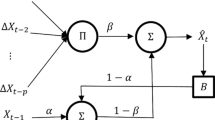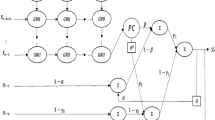Abstract
Deep artificial neural networks have been popular for time series forecasting literature in recent years. The recurrent neural networks present more suitable architectures for forecasting problems than other deep neural network types. The simplest deep recurrent neural network type is simple recurrent neural networks according to the number of employed parameters. These neural networks can be preferred to solve forecasting problems because of their simple structure if they are trained well. Unfortunately, the training of simple recurrent neural networks is problematic because of exploding or vanishing gradient problems. The contribution of this study is proposing a new training algorithm based on particle swarm optimization. The algorithm does not use gradients so it has not vanished or exploding gradient problem. The performance of the new training algorithm is compared with long short-term memory trained by the Adam algorithm and Pi-Sigma artificial neural network. In the applications, ten-time series are used to compare the performance of the methods. The ten-time series is consisting of daily observations of the Dow-Jones and Nikkei stock exchange opening prices between the years 2014 and 2018. At the end of the analysis processes, the proposed method produces more accurate forecast results than established benchmarks.



Similar content being viewed by others
References
Akdeniz E, Egrioglu E, Bas E, Yolcu U (2018) An ARMA type Pi-Sigma artificial neural network for nonlinear time series forecasting. J Artif Intell Soft Comput 8:121–132
Bas E, Egrioglu E, Yolcu U, Grosan C (2019) Type 1 fuzzy function approach based on ridge regression for forecasting. Granul Comput 4:629–637
Bas E, Yolcu U, Egrioglu E (2020) Intuitionistic fuzzy time series functions approach for time series forecasting. Granul Comput. https://doi.org/10.1007/s41066-020-00220-8
Bisht K, Kumar S (2019) Hesitant fuzzy set based computational method for financial time series forecasting. Granul Comput 4:655–669
Chang JR, Yu PY (2019) Weighted-fuzzy-relations time series for forecasting information technology maintenance cost. Granul Comput 4:687–697
Chen SM, Hsu CC (2008) A new approach for handling forecasting problems using high-order fuzzy time series. Intell Autom Soft Comput 14(1):29–43
Chen SM, Wang N (2010) Fuzzy forecasting based on fuzzy-trend logical relationship groups. IEEE Trans Syst Man Cybernetics Part B 40(5):1343–1358
Chen SM, Manalu GMT, Pan J, Liu H (2013) Fuzzy forecasting based on two-factors second-order fuzzy-trend logical relationship groups and particle swarm optimization techniques. IEEE Trans Cybernetics 43(3):1102–1117
Chen SM, Phuong BDH (2016) Fuzzy time series forecasting based on optimal partitions of intervals and optimal weighting vectors. Knowl Based Syst 118:204–216
Chen SM, Jian WS (2017) Fuzzy forecasting based on two-factors second-order fuzzy-trend logical relationship groups, similarity measures and PSO techniques. Inf Sci 391:65–79
Chen J, Xing H, Yang H, Xu L (2018) Network traffic prediction based on LSTM networks with genetic algorithm. In: International Conference on Signal and Information Processing, Networking and Computers, pp 411–419
Chen SM, Zou XY, Gunawan GC (2019) Fuzzy time series forecasting based on proportions of intervals and particle swarm optimization techniques. Inf Sci 500:127–139
Chen J, Yuan W, Cao J, Lv H (2020) Traffic-flow prediction via granular computing and stacked autoencoder. Granul Comput 5:449–459
Chung H, Shin KS (2018) Genetic algorithm-optimized long short-term memory network for stock market prediction. Sustainability 10(10):3765
Egrioglu E, Yolcu U, Aladag CH, Bas E (2014) Recurrent multiplicative neuron model artificial neural network for non-linear time series forecasting. Neural Process Lett 41(2):249–258
Egrioglu E, Yolcu U, Bas E (2019) Intuitionistic high-order fuzzy time series forecasting method based on pi-sigma artificial neural networks trained by artificial bee colony. Granul Comput 4:639–654
Egrioglu E, Fildes R, Bas E (2021) Recurrent fuzzy time series functions approach for forecasting. Granul Comput. https://doi.org/10.1007/s41066-021-00257-3
Fan MH, Chen MY, Liao EC (2019) A deep learning approach for financial market prediction: utilization of Google trends and keywords. Granul Comput 6:207–216
Gao MY, Zhang N, Shen SL, Zhou A (2020) Real-time dynamic earth-pressure regulation model for shield tunneling by integrating GRU Deep learning method with GA optimization. IEEE Access 8:64310–64323
Gundu V, Simon SP (2021) PSO–LSTM for short-term forecast of heterogeneous time series electricity price signals. J Ambient Intell Hum Comput 12:2375–2385
Gupta KK, Kumar S (2019a) A novel high-order fuzzy time series forecasting method based on probabilistic fuzzy sets. Granul Comput 4:699–713
Gupta KK, Kumar S (2019b) Hesitant probabilistic fuzzy set based time series forecasting method. Granul Comput 4:739–758
Hochreiter S, Schmidhuber J (1997) Long short-term memory. Neural Comput 9:1735–1780
Ibrahim AM, El-Amary NH (2018) Particle swarm optimization trained recurrent neural network for voltage instability prediction. J Electr Syst Inf Technol 5(2):216–228
Kim TY, Cho SB (2019) Particle swarm optimization-based CNN-LSTM networks for forecasting energy consumption. In: 2019 IEEE Congr Evol Comput CEC 2019—Proc, pp 1510–1516
Lu W, Rui H, Liang C, Jiang L, Zhao S, Li K (2020) A method based on GA-CNN-LSTM for daily tourist flow prediction at scenic spots. Entropy 22(3):01–18
Ma L, Ge Y, Cao X (2012) Superheated steam temperature control based on improved recurrent neural network and simplified PSO algorithm. Appl Mech Mater 128:1065–1069
Moalla H, Elloumi W, Alimi AM (2017) H-PSO-LSTM: Hybrid LSTM trained by PSO for online handwriting identification. In: International Conference on Neural Information Processing, pp 41–50
Peng L, Liu S, Liu R, Wang L (2018) Effective long short-term memory with differential evolution algorithm for electricity price prediction. Energy 162:1301–1314
Pham DT, Karaboga D (1999) Training Elman and Jordan networks for system identification using genetic algorithms. Artif Intell Eng 13:107–117
Qiu J, Tian J, Chen H, Lu X (2018) Prediction method of parking space based on genetic algorithm and RNN. In: Pacific Rim Conference on Multimedia, pp 865–876
Qiu YY, Zhang Q, Lei M (2020) Forecasting the railway freight volume in China based on combined PSO-LSTM model. J Phys 1651(1):012029
Shao B, Li M, Zhao Y, Bian G (2019) Nickel price forecast based on the LSTM neural network optimized by the improved PSO algorithm. Mathematical Problems in Engineering 2019.
Shin Y, Gosh J (1991) The Pi-Sigma network: an efficient higher order neural network for pattern classification and function approximation. In: Proceedings of the International Joint Conference on Neural Networks, Seattle, pp 13–18
Stajkowski S, Kumar D, Samui P, Bonakdari H, Gharabaghi B (2020) Genetic-algorithm-optimized sequential model for water temperature prediction. Sustainability 12(13):5374
Wang X, Ma L, Wang B, Wang T (2013) A hybrid optimization-based recurrent neural network for real-time data prediction. Neurocomputing 120:547–559
Wu F, Yan S, Smith JS, Zhang B (2021) Deep multiple classifier fusion for traffic scene recognition. Granular Computing 6:217–228
Xu R, Wunsch DC II, Frank R (2007) Inference of genetic regulatory networks with recurrent neural network models using particle swarm optimization. IEEE/ACM Trans Comput Biol Bioinf 4(4):681–692
Yao Y, Han L, Wang J (2018) LSTM-PSO: Long Short-Term Memory ship motion prediction based on particle swarm optimization. In: 2018 IEEE CSAA Guidance, Navigation and Control Conference (CGNCC), pp 1–5
Yuan X, Chen C, Jiang M, Yuan Y (2019) Prediction interval of wind power using parameter optimized Beta distribution-based LSTM model. Applied Soft Computing 82:105550
Zhang N, Behera PK, Williams C (2013) Solar radiation prediction based on particle swarm optimization and evolutionary algorithm using recurrent neural networks. In: 2013 IEEE International Systems Conference (SysCon), pp 280–286.
Zeng S, Chen SM, Teng MO (2019) Fuzzy forecasting based on linear combinations of independent variables, subtractive clustering algorithm and artificial bee colony algorithm. Inf Sci 484:350–366
Author information
Authors and Affiliations
Corresponding author
Ethics declarations
Conflict of interest
The author declares that there is no conflict of interest toward the publication of this manuscript.
Additional information
Publisher's Note
Springer Nature remains neutral with regard to jurisdictional claims in published maps and institutional affiliations.
Rights and permissions
About this article
Cite this article
Bas, E., Egrioglu, E. & Kolemen, E. Training simple recurrent deep artificial neural network for forecasting using particle swarm optimization. Granul. Comput. 7, 411–420 (2022). https://doi.org/10.1007/s41066-021-00274-2
Received:
Accepted:
Published:
Issue Date:
DOI: https://doi.org/10.1007/s41066-021-00274-2




